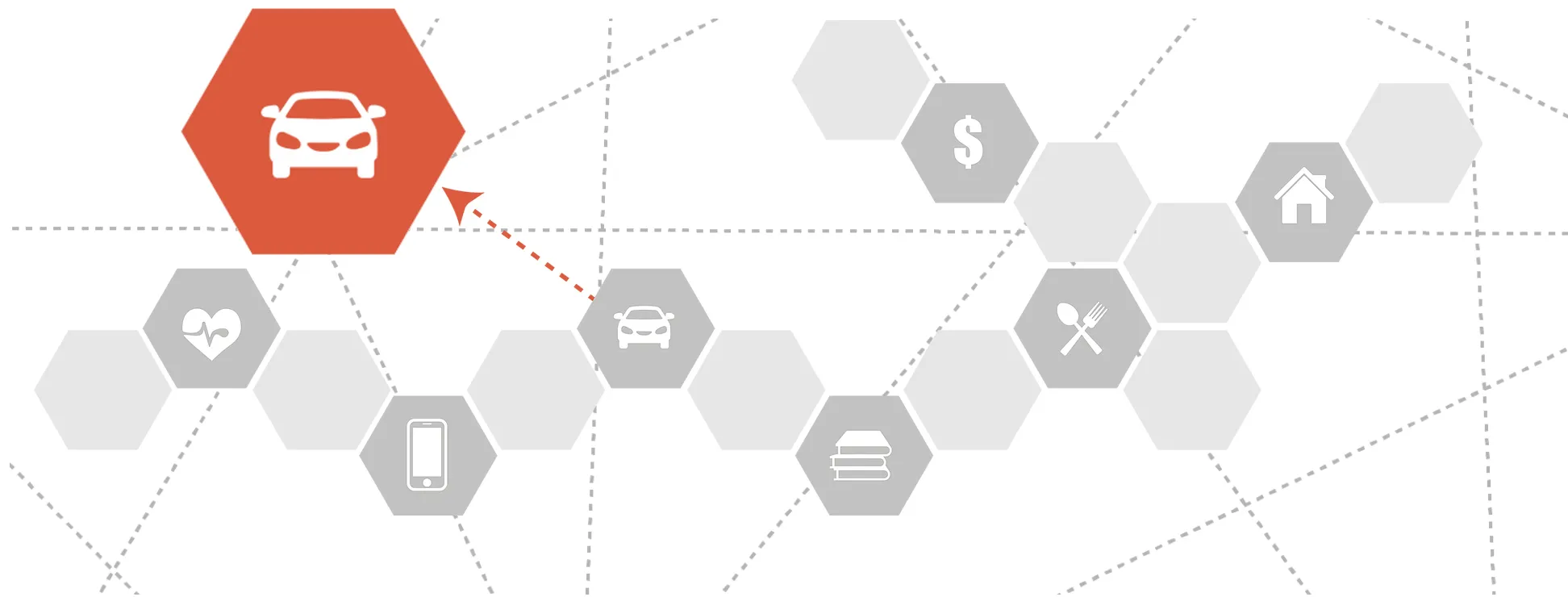
|
Housingclick to view |

|
Health Careclick to view |

|
Child Care and Educationclick to view |

|
Technologyclick to view |

|
Foodclick to view |

|
Taxesclick to view |

|
Transportationclick to view |
||
Impact on ALICE
What do families do when they cannot afford a vehicle?
In most parts of the U.S., owning or leasing a vehicle is necessary in order to get from place to place. Public transportation systems, including busses, trains, subways, and light rail, do not operate in most areas, especially ones that are more rural or have a lower population density. With low income, little or no savings, and a range of family and work responsibilities, families have limited choices. These are strategies that different ALICE families try:
Reduce Other Expenditures
While it may seem obvious to spend less elsewhere, it is difficult for families on an already tight budget to make further reductions. Because a vehicle is essential for work, families often make sacrifices with significant consequences in order to own or lease, and maintain, a vehicle.
While it may seem obvious to spend less elsewhere, it is difficult for families on an already tight budget to make further reductions. Because a vehicle is essential for work, families often make sacrifices with significant consequences in order to own or lease, and maintain, a vehicle.

Buy a Lower Cost Vehicle
One way to mitigate the cost of buying a car is to purchase a lower-priced, used vehicle. This is often a good option depending on the age and condition of the vehicle, but it requires enough money up front for a down payment.
One way to mitigate the cost of buying a car is to purchase a lower-priced, used vehicle. This is often a good option depending on the age and condition of the vehicle, but it requires enough money up front for a down payment.

Delay or Avoid Payments
Other costs of owning a vehicle include insurance, registration fees, and traffic fines, any one of which can be prohibitive. A car owner might decide not to pay for insurance, register a vehicle (which incurs an annual fee and possibly repairs needed for the vehicle to pass inspection), or pay speeding, parking, or other traffic tickets. Any one of these actions can have serious long-term consequences.
Other costs of owning a vehicle include insurance, registration fees, and traffic fines, any one of which can be prohibitive. A car owner might decide not to pay for insurance, register a vehicle (which incurs an annual fee and possibly repairs needed for the vehicle to pass inspection), or pay speeding, parking, or other traffic tickets. Any one of these actions can have serious long-term consequences.

Use Public Transportation
ALICE workers could decide to save money by using public transportation, which costs far less than owning a vehicle, or moving to an area where public transportation is available. Nationally in 2017, only 5 percent of adults used public transit to commute to work, with most of these commuters concentrated in urban areas.17 Only 3 percent of workers in rural areas reported using public transit regularly. The highest levels of public transit ridership are among immigrant (25 percent), Black (23 percent), Hispanic (15 percent), and low-income (15 percent) workers.18
ALICE workers could decide to save money by using public transportation, which costs far less than owning a vehicle, or moving to an area where public transportation is available. Nationally in 2017, only 5 percent of adults used public transit to commute to work, with most of these commuters concentrated in urban areas.17 Only 3 percent of workers in rural areas reported using public transit regularly. The highest levels of public transit ridership are among immigrant (25 percent), Black (23 percent), Hispanic (15 percent), and low-income (15 percent) workers.18

Sources
3
AAA. (2017, August 23). AAA reveals true cost of vehicle ownership. Retrieved from https://newsroom.aaa.com/tag/cost-to-own-a-vehicle/
Bricker, J., Kennickell, A., Moore, K., & Sabelhaus, J. (2012, June). Changes in U.S. family finances from 2007 to 2010: Evidence from the Survey of Consumer Finances. Federal Reserve Bulletin, 98(2). Retrieved from http://www.federalreserve.gov/pubs/bulletin/2012/pdf/scf12.pdf
Consumer Reports. (2017). The cost of car ownership over time: Expenses can skyrocket when warranty and free-maintenance periods are over. Retrieved from https://www.consumerreports.org/car-maintenance/the-cost-of-car-ownership/
4
AAA. (2017, August 23). AAA reveals true cost of vehicle ownership. Retrieved from https://newsroom.aaa.com/tag/cost-to-own-a-vehicle/
Bricker, J., Kennickell, A., Moore, K., & Sabelhaus, J. (2012, June). Changes in U.S. family finances from 2007 to 2010: Evidence from the Survey of Consumer Finances. Federal Reserve Bulletin, 98(2). Retrieved from http://www.federalreserve.gov/pubs/bulletin/2012/pdf/scf12.pdf
Agrawal, A. W., Blumenberg, E. A., Abel, S., Pierce, G., & Darrah, C. N. (2011). Getting around when you’re just getting by: The travel behavior and transportation expenditures of low-income adults. Mineta Transportation Institute. Retrieved from http://transweb.sjsu.edu/MTIportal/research/publications/documents/2806_10-02.pdf
5
Consumer Reports. (2017). The cost of car ownership over time: Expenses can skyrocket when warranty and free-maintenance periods are over. Retrieved from https://www.consumerreports.org/car-maintenance/the-cost-of-car-ownership/
6
AAA. (2017, August 23). AAA reveals true cost of vehicle ownership. Retrieved from https://newsroom.aaa.com/tag/cost-to-own-a-vehicle/
Bricker, J., Kennickell, A., Moore, K., & Sabelhaus, J. (2012, June). Changes in U.S. family finances from 2007 to 2010: Evidence from the Survey of Consumer Finances. Federal Reserve Bulletin, 98(2). Retrieved from http://www.federalreserve.gov/pubs/bulletin/2012/pdf/scf12.pdf
Agrawal, A. W., Blumenberg, E. A., Abel, S., Pierce, G., & Darrah, C. N. (2011). Getting around when you’re just getting by: The travel behavior and transportation expenditures of low-income adults. Mineta Transportation Institute. Retrieved from http://transweb.sjsu.edu/MTIportal/research/publications/documents/2806_10-02.pdf
7
Center for Transit Oriented Development. (2012). Families and transit-oriented development. Retrieved from http://ctod.org/pdfs/tod205.pdf
Dawkins, C., Jeon, J. S., & Pendall, R. (2015). Transportation access, rental vouchers, and neighborhood satisfaction: Evidence from the moving to opportunity experiment. Housing Policy Debate, 497–530. Retrieved from http://www.tandfonline.com/doi/abs/10.1080/10511482.2014.986662?journalCode=rhpd20
8
Criden, M. (2008). The stranded poor: Recognizing the importance of public transportation for low-income households. Retrieved from https://nascsp.org/wp-content/uploads/2018/02/issuebrief-benefitsofruralpublictransportation.pdf
9
American Community Survey. (2017). Table S0802: Means of transportation to work by selected characteristics, 1-year estimates. U.S. Census Bureau. Retrieved from https://factfinder.census.gov/bkmk/table/1.0/en/ACS/17_1YR/S0802
10
Heller, D., & Styczynski, M. (2016). Major auto insurers raise rates based on economic factors. Consumer Federation of America. Retrieved from http://consumerfed.org/wp-content/uploads/2016/06/6-27-16-Auto-Insurance-and-Economic-Status_Report.pdf
11
Wiltz, T. (February 20, 2015). Why uninsured drivers cost us over $2.6 billion a year. The Fiscal Times. Retrieved from http://www.thefiscaltimes.com/2015/02/20/Why-Uninsured-Drivers-Cost-Us-Over-26-Billion-Year
University of Wisconsin-Milwaukee Employment & Training Institute. (2015). Driver’s license issues and recommendations. Retrieved from http://www4.uwm.edu/eti/2015/DriversIssuesJune2015.pdf
12
American Association of Motor Vehicle Administrators. (2013). Working group releases best practices guide to reducing suspended drivers. Retrieved from http://www.aamva.org/Suspended-and-Revoked-Drivers-Working-Group/
PBS NewsHour. (2014). Without funds to pay fines, minor incidents can mean jail time. Retrieved from https://www.pbs.org/newshour/show/without-funds-pay-fines-minor-incidents-can-mean-jail
Urbana IDOT Traffic Stop Data Task Force. (2015, July 2). Preliminary findings. Retrieved from http://will.illinois.edu/nfs/idottraffic-stop-data-task-force-preliminary-findings.pdf
Lawyers Committee for Civil Rights. (2015, April 20). Not just a Ferguson problem: How traffic courts drive inequality in California. Retrieved from http://www.lccr.com/wp-content/uploads/Not-Just-a-Ferguson-Problem-How-Traffic-Courts-Drive-Inequality-in-California-4.20.15.pdf
Eaglin, J. (2015). Driver’s license suspensions perpetuate the challenges of criminal justice debt. Brennan Center for Justice. Retrieved from https://www.brennancenter.org/blog/drivers-license-suspensions-perpetuate-challenges-criminal-justice-debt
Anderson, M. (2016). Who relies on public transit in the U.S. Pew Research Center. Retrieved from https://www.pewresearch.org/fact-tank/2016/04/07/who-relies-on-public-transit-in-the-u-s/
13
Angwin, J., Larson, J., Kirchner, L., & Mattu, S. (2017, April 21). Car insurance companies charge higher rates in some minority neighborhoods. Consumer Reports. Retrieved from https://www.consumerreports.org/consumer-protection/car-insurance-companies-charge-higher-rates-in-some-minority-neighborhoods/
University of Wisconsin-Milwaukee Employment & Training Institute. (2015). Driver’s license issues and recommendations. Retrieved from http://www4.uwm.edu/eti/2015/DriversIssuesJune2015.pdf
American Association of Motor Vehicle Administrators. (2013). Working group releases best practices guide to reducing suspended drivers. Retrieved from http://www.aamva.org/Suspended-and-Revoked-Drivers-Working-Group/
PBS NewsHour. (2014). Without funds to pay fines, minor incidents can mean jail time. Retrieved from https://www.pbs.org/newshour/show/without-funds-pay-fines-minor-incidents-can-mean-jail
14
Angwin, J., Larson, J., Kirchner, L., & Mattu, S. (2017, April 21). Car insurance companies charge higher rates in some minority neighborhoods. Consumer Reports. Retrieved from https://www.consumerreports.org/consumer-protection/car-insurance-companies-charge-higher-rates-in-some-minority-neighborhoods/
15
Ong, P. M., & Stoll, M. A. (2007, September 7). Redlining or risk? A spatial analysis of auto insurance in Los Angeles. Journal of Policy Analysis and Management, 26(4), 811–830. Retrieved from http://onlinelibrary.wiley.com/doi/10.1002/pam.20287/full
16
Wiltz, T. (February 20, 2015). Why uninsured drivers cost us over $2.6 billion a year. The Fiscal Times. Retrieved from http://www.thefiscaltimes.com/2015/02/20/Why-Uninsured-Drivers-Cost-Us-Over-26-Billion-Year
Eaglin, J. (2015). Driver’s license suspensions perpetuate the challenges of criminal justice debt. Brennan Center for Justice. Retrieved from https://www.brennancenter.org/blog/drivers-license-suspensions-perpetuate-challenges-criminal-justice-debt
The Center for Neighborhood Technology. (2019). AllTransitTM rankings. Retrieved from https://alltransit.cnt.org/rankings/
17
American Community Survey. (2017). Table S0802: Means of transportation to work by selected characteristics, 1-year estimates. U.S. Census Bureau. Retrieved from https://factfinder.census.gov/bkmk/table/1.0/en/ACS/17_1YR/S0802
18
American Community Survey. (2017). Table S0802: Means of transportation to work by selected characteristics, 1-year estimates. U.S. Census Bureau. Retrieved from https://factfinder.census.gov/bkmk/table/1.0/en/ACS/17_1YR/S0802
19
The Center for Neighborhood Technology. (2019). AllTransitTM rankings. Retrieved from https://alltransit.cnt.org/rankings/
20
Agrawal, A. W., Blumenberg, E. A., Abel, S., Pierce, G., & Darrah, C. N. (2011). Getting around when you’re just getting by: The travel behavior and transportation expenditures of low-income adults. Mineta Transportation Institute. Retrieved from http://transweb.sjsu.edu/MTIportal/research/publications/documents/2806_10-02.pdf
21
Agrawal, A. W., Blumenberg, E. A., Abel, S., Pierce, G., & Darrah, C. N. (2011). Getting around when you’re just getting by: The travel behavior and transportation expenditures of low-income adults. Mineta Transportation Institute. Retrieved from http://transweb.sjsu.edu/MTIportal/research/publications/documents/2806_10-02.pdf
Angwin, J., Larson, J., Kirchner, L., & Mattu, S. (2017, April 21). Car insurance companies charge higher rates in some minority neighborhoods. Consumer Reports. Retrieved from https://www.consumerreports.org/consumer-protection/car-insurance-companies-charge-higher-rates-in-some-minority-neighborhoods/
Remer, W. (2016, December 15). 2017 infrastructure report card: A big WIIN for water resources. American Society of Civil Engineers (ASCE). Retrieved from http://www.infrastructurereportcard.org/a/#p/home
22
American Community Survey. (2017). Table S0802: Means of transportation to work by selected characteristics, 1-year estimates. U.S. Census Bureau. Retrieved from https://factfinder.census.gov/bkmk/table/1.0/en/ACS/17_1YR/S0802
23
Angwin, J., Larson, J., Kirchner, L., & Mattu, S. (2017, April 21). Car insurance companies charge higher rates in some minority neighborhoods. Consumer Reports. Retrieved from https://www.consumerreports.org/consumer-protection/car-insurance-companies-charge-higher-rates-in-some-minority-neighborhoods/
Sullivan, J. (2015, April 21). How commute issues can dramatically impact employee retention. Retrieved from TLNT: https://www.tlnt.com/how-commute-issues-can-dramatically-impact-employee-retention/

